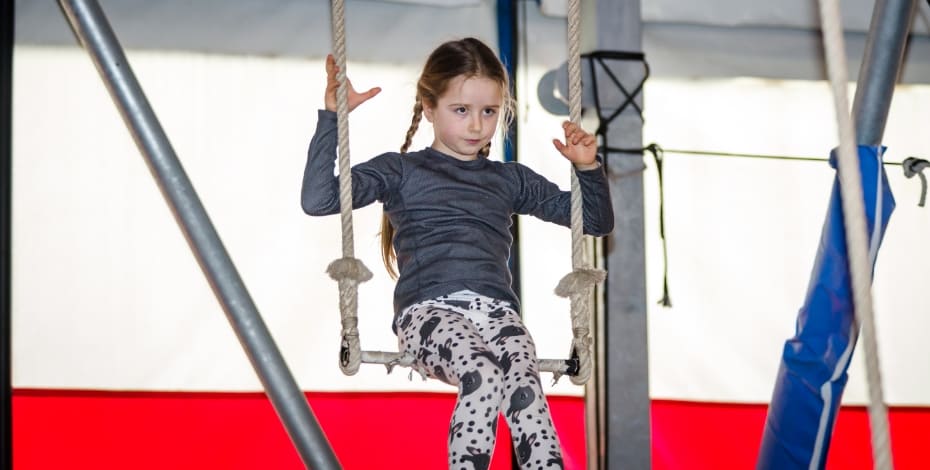
Circus arts for children born preterm

A study examining the co-design and subsequent feasibility of a health intervention for preschoolers born preterm brought together physiotherapists, parents and circus coaches.
Free Coulston APAM, a lecturer in physiotherapy at the University of Melbourne and a former circus educator, combined two of her passions in an effort to help children born extremely preterm/premature (EP).
Around eight per cent of births in Australia are preterm (less than 37 weeks gestation).
Children whose births are classified as EP (less than 28 weeks gestation) show an increased risk of developing motor, cognitive and behavioural issues.
They also generally participate less in physical activity.
While circus has traditionally been viewed as a form of entertainment, research shows that many of the physical activities that circus artists engage in—such as trapeze, juggling, balancing and tumbling—can provide a wide range of benefits for physical, emotional and mental health.
In 2020, Free was awarded a $10,000 Physiotherapy Research Foundation (PRF) Seeding Grant, enabling her to undertake research titled ‘The Circus Project: A physiotherapy-informed co-designed circus intervention for preschoolers born EP’.
The project was co-designed, which meant that parents of children born EP could work alongside paediatric health professionals, circus coaches and the researchers to explore ways in which circus interventions could best benefit children like their own.
‘Going into the study, we knew that by preschool age, children born preterm have lower rates of physical activity compared to typically developing peers born at term’ says Free.
‘But there wasn’t a lot of information about exactly what the barriers are to participating in physical activity.
'So another outcome from this study was a paper that clearly shows barriers and supports to participating in community-based physical activity for this age group from the perspectives of the parents, clinicians and coaches.’
One of the barriers relates to the trauma of medical complications.
‘Many of the children still have long-lasting challenges such as chronic lung disease or movement disorders’ says Free.
‘So their parents don’t want their child to be exposed to any risk, injury or further illness.
'We had a lot of feedback from parents of children born preterm, explaining, “This is what it means for us.”'
'Once that information had been put into a manageable course for the coaches, all of a sudden their response was, “We’ve got it now; it doesn’t feel difficult or unknown.”’
Having started her PhD only a few weeks before Melbourne went into its first COVID-19 lockdown in March 2020, Free found that the restrictions had an unexpectedly positive outcome.
‘We rigorously worked out a co-design process for an online environment that would carefully and authentically uphold all of the principles and values of in-person co-design’ says Free.
‘I think it will be a great tool for clinicians and other stakeholders wanting to design interventions with patients who may be geographically unable to use in-person processes.’
The response, says Free, has been overwhelmingly positive.
‘The feedback from clinicians so far is that they see a lot of children born preterm and/or with developmental delay and this gives them confidence that there are places they can refer these children that they know will be furthering the therapy they’re providing in the clinic, reinforcing all the stuff they’re doing therapeutically every day as well as building up physical activity for these kids.’
The next stage of Free’s research will involve expanding the project beyond circus arts to include other physical activities.
‘We will open it up to other sports and go through the co-design process so that we can align the principles of this intervention more broadly to more sports because it’s much better if kids choose the sport they want to do.’
This has been made possible due to a recent Medical Research Future Fund grant of over $1 million, which wouldn’t have come about without the PRF.
‘For me, there have been lots of benefits from the PRF grant—which was the first grant I ever got—such as exposure and being eligible for travelling and scholarship grants and conferences’ says Free.
'But the main benefit is the flow-on effect—I can clearly see how getting the PRF grant led to this Medical Research Future Fund grant.
'If I hadn’t got that first PRF one, that snowball effect wouldn’t have happened to get us to where we are now. I’m just so grateful.’
Perseverance, nous and a touch of serendipity have certainly worked in Free’s favour.
‘I got to combine my passion for circus with my clinical background in physiotherapy and I also had a three-year- old at the time, so it all felt very holistic, everything coming together.’
Course of interest:
Paediatric Physiotherapy Level 1 - Part A
© Copyright 2025 by Australian Physiotherapy Association. All rights reserved.





